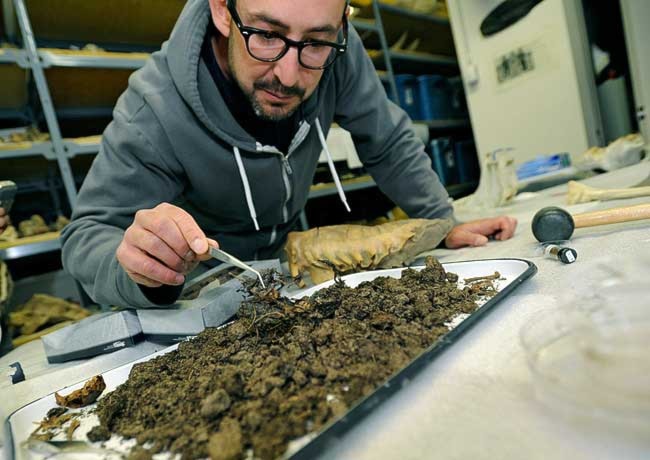The BBC and the Discovery Channel recently visited the Yukon to make an unlikely star out of the ancient Arctic ground squirrel.
The production team spent a week with Grant Zazula from the government’s paleontology program to learn about the small creature that left a curious record of the last ice age’s climate.
Zazula was surprised that the famed production company behind the Planet Earth series and dozens of other nature documentaries wanted to feature his research.
“Everyone is interested in mammoths or saber tooth tigers or lions, and nobody’s really interested in squirrels cause they’re these stupid little animals, right?”
The ancient ground squirrel is very much the same animal that we see scampering around some parts of the territory today, and its behaviours and genetics have remained more or less unchanged for at least a million years.
The squirrel burrows into the ground above the permafrost and makes a nest of plant material to hibernate in over the winter.
The males collect a food cache of seeds and keep that with them in the nest.
“One person described them as little furry botanists that ran around and collected all the plants and stored them underground,” Zazula said.
The squirrels “kind of collect things at random” for the cache, and that means that the nests contain a record of what the plant life was in the area at the time.
Ancient nests from the ice age have been frozen and preserved in the permafrost, along with the seed caches and sometimes the remains of squirrels that didn’t make it through the winter.
Zazula spent years dissecting the recovered frozen nests and collecting the tiny biological treasures found inside.
When they are found, they look like balls of hay, about 30 or 40 centimetres across, sticking out of the mud.
Zazula has collected a good record of the plant life in the Klondike area dating back 100,000 years, thanks to the caches.
[image2]
About 70 species of plants and seeds have been found and documented.
He has found a few nests as old as 750,000 years.
It’s special to have such a complete record of not only where an animal was at what time, but also the kinds of things they did to survive in the environment, said Zazula.
“With a lot of prehistoric animals you don’t really get a chance to understand their behaviour so much, because you just have a bunch of bone.”
For over a hundred years here in the Yukon, paleontology and gold mining have been unlikely collaborators.
Archival photos from the earliest gold rush days show placer miners posing with mammoth tusks and similarly impressive ice-age artifacts recovered from the permafrost.
In order to get at the gold in ancient gravel creek beds, miners have to first remove what could be 40 or 50 metres of frozen mud.
That muck accumulated from sediment deposited over the ice age, when giant mammals roamed over Beringia’s mammoth steppe.
The most recent ice age, or the Quaternary period, dates from about 2.6 million years ago to about 10,000 years ago.
During most of that time, the climate was much colder than it is today, although there were several shorter “interglacial” periods within the ice age where the climate was warm.
In the cold periods much of the Earth’s moisture was locked up in glaciers, and parts of the Yukon were connected with Alaska and Siberia over the Bering land bridge.
When miners thaw and wash away the frozen ground, they uncover the fossilized remains of ice age history, including the squirrel nests.
The paleontology program works with the Klondike’s placer miners to recover the bones and mummified carcasses retrieved from the muck.
The industrial scale of mining in the territory has allowed for an extensive fossil collection that keeps growing.
“The amount of ground they move allows us to do our work,” Zazula said.
Bags of this summer’s recovered treasures take over a corner of the paleontology program’s warehouse in Whitehorse’s industrial area, loosely piled together and briefly labelled.
Most of the space is filled with compact movable shelving displaying mammoth bones and other artifacts, from floor to ceiling.
The BBC documentary team shot footage both in the lab and in the Klondike gold fields. The three-part series about the ice age will air on the Discovery Channel some time next year.
The filmakers told Zazula that the ice age is “kind of a sexy topic” right now, and his research about the ground squirrel would add an interesting element to the project.
When Zazula tries to get his young son interested in his work, he compares the Arctic ground squirrel to the mischievous and beloved Scrat character from the Ice Age animated children’s movies.
“I try to get it in their heads that sometimes it’s not the biggest animals that are the coolest ones.”
Contact Jacqueline Ronson at
jronson@yukon-news.com
